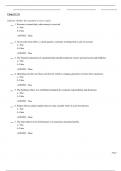Exam (elaborations)
Test Bank for Corporate Financial Accounting, 17th Edition by Carl Warren
- Course
- Institution
Test Bank for Corporate Financial Accounting, 17e 17th Edition by Carl Warren, Jeff Jones, William B. Tayler. Complete Chapters (Chapter 1 to 14) are included with answers. 1. Introduction to Accounting and Business. 2. Analyzing Transactions. 3. The Adjusting Process. 4. Completing the Accou...
[Show more]



